A 1.8 m Class Pathfinder Raman LIDAR for the Northern Site of the Cherenkov Telescope Array Observatory—Technical Design
Abstract
:1. Introduction
2. Technical Requirements
2.1. Scientific and Performance Requirements
2.2. Operation and Survival Conditions
2.3. Reliability and Availability
3. pBRL Technical Design
3.1. The Original CLUE Container
3.2. The Telescope Chassis and Petals
3.3. The Primary Mirror
3.4. Telescope Optics Design
3.5. Coaxial Laser Beam
3.6. Liquid Light Guide
3.7. Optical Bench Polychromator
3.8. Readout Electronics
3.9. The Laser
3.10. The Laser Dichroic Guiding Mirrors
3.11. Stability of the Guide Mirror Structure and Mount
3.12. Short-Range System
4. Commissioning, Calibration and Monitoring
4.1. Calibration of the Pointing and Beam Alignment
4.2. Calibration of the Timing
4.3. Calibration of the Telescope Pointing
4.4. Calibration of the Discriminator Thresholds
4.5. Monitoring of the Telescope Reflectivity
5. pBRL Operation
5.1. Command Line Interface Semi-Remote Operation and GRAFANA Monitoring
5.2. Preparation
- Heat-up of the laser. The industrial hot air blower was turned on if the outside temperature required it. The laser operating temperature of 32 °C was reached in about 5–10 min depending on the outside temperature.
- Open the container walls. This operation took about a minute.
- Initialization of the laser arm and movement to the aligned position.
- Telescope preparation. The telescope system was moved out of the park position to an elevation angle of about 32°. In order to test full movement control, it was also moved back and forth in azimuth of a few degrees. Once the test was successful, the protective petals of the mirrors were folded open.
- The LICEL electronics were turned on.
- Ramp up the High Voltage of the PMTs to pre-defined settings.
- Power off the industrial hot air blower. When the laser reached the final temperature, the external heating system was switched off.
- Power on the laser. The laser was initialized without firing and set to 5% laser power.
5.3. Data Taking
- Open the LLG shutter protection.
- Set the laser power to the default power of 80%, define the number of shots (default: 1000) and fire the laser.
- After taking a data set, the laser was set to pause mode.
- Repeat steps 2 to 3 as often as possible within the time limits or if weather conditions allow.
5.4. System Shut-Down
6. Summary and Conclusions
Author Contributions
Funding
Data Availability Statement
Acknowledgments
Conflicts of Interest
References
- Acharya, B.S.; Actis, M.; Aghajani, T.; Agnetta, G.; Aguilar, J.; Aharonian, F.; Ajello, M.; Akhperjanian, A.; Alcubierre, M.; Aleksić, J.; et al. Introducing the CTA concept. Astropart. Phys. 2013, 43, 3–18. [Google Scholar] [CrossRef]
- The Cherenkov Telescope Array Consortium; Acharya, B.S.; Agudo, I.; Samarai, I.A.; Alfaro, R.; Alfaro, J.; Alispach, C.; Alves Batista, R.; Amans, J.P. Science with the Cherenkov Telescope Array; World Scientific: Singapore, 2019; p. 364. [Google Scholar] [CrossRef]
- Navas, S.; Amsler, C.; Gutsche, T.; Hanhart, C.; Hernández-Rey, J.J.; Lourenço, C.; Masoni, A.; Mikhasenko, M.; Mitchell, R.E.; Patrignani, C.; et al. (Particle Data Group). 34 Passage of Particles Through Matter. Phys. Rev. D 2024, 110, 030001. Available online: https://pdg.lbl.gov/2024/AtomicNuclearProperties/HTML/air_dry_1_atm.html (accessed on 6 March 2025). [CrossRef]
- Hillas, A.M.; Patterson, J.R. Characteristics and brightness of Cerenkov shower images for gamma-ray astronomy near 1 TeV. J. Phys. G-Nucl. Part. Phys. 1990, 16, 1271–1281. [Google Scholar] [CrossRef]
- Schmuckermaier, F.; Gaug, M.; Fruck, C.; Moralejo, A.; Hahn, A.; Prester, D.D.; Dorner, D.; Font, L.; Mićanović, S.; Mirzoyan, R.; et al. Correcting Imaging Atmospheric Cherenkov Telescope data with atmospheric profiles obtained with an elastic light detecting and ranging system. Astron. Astrophys. 2023, 673, A2. [Google Scholar] [CrossRef]
- Fruck, C. The Galactic Center Resolved with MAGIC and a New Technique for Atmospheric Calibration. Ph.D. Thesis, Technische Unversität München, München, Germany, 2015. Available online: https://mediatum.ub.tum.de/doc/1237928/document.pdf (accessed on 6 March 2025).
- de Naurois, M. L’expérience CELESTE: Reconversion d’une Centrale Solaire Pour l’Astronomie Gamma. Première Observation de la Nébuleuse du Crabe et du Blazar Markarian 421 entre 30 et 300 GeV. Ph.D. Thesis, Université Pierre et Marie Curie—Paris VI, Paris, France, 2000. Available online: https://tel.archives-ouvertes.fr/tel-00004261 (accessed on 6 March 2025).
- Bernlöhr, K. Impact of atmospheric parameters on the atmospheric Cherenkov technique. Astropart. Phys. 2000, 12, 255–268. [Google Scholar] [CrossRef]
- Munar-Adrover, P.; Gaug, M. Studying molecular profiles above the Cherenkov Telescope Array sites. Eur. Phys. J. Web Conf. 2019, 197, 01002. [Google Scholar] [CrossRef]
- Ebr, J.; Mandat, D.; Pech, M.; Chytka, L.; Jurysek, J.; Prouza, M.; Janeček, P.; Trávníček, P.; Blažek, J.; Bulik, T.; et al. Characterization of atmospheric properties at the future sites of the Cherenkov Telescope Array. In Proceedings of the 36th International Cosmic Ray Conference (ICRC2019), Madison, WI, USA,, 24 July–1 August 2019; Volume 36, p. 667. [Google Scholar]
- Fruck, C.; Gaug, M.; Hahn, A.; Acciari, V.; Besenrieder, J.; Dominis Prester, D.; Dorner, D.; Fink, D.; Font, L.; Mićanović, S.; et al. Characterizing the aerosol atmosphere above the Observatorio del Roque de los Muchachos by analysing seven years of data taken with an GaAsP HPD-readout, absolutely calibrated elastic LIDAR. MNRAS 2022, 515, 4520–4550. [Google Scholar] [CrossRef]
- García-Gil, A.; Muñoz-Tuñón, C.; Varela, A.M. Atmosphere Extinction at the ORM on La Palma: A 20 yr Statistical Database Gathered at the Carlsberg Meridian Telescope. PASP 2010, 122, 1109. [Google Scholar] [CrossRef]
- Kremser, S.; Thomason, L.W.; von Hobe, M.; Hermann, M.; Deshler, T.; Timmreck, C.; Toohey, M.; Stenke, A.; Schwarz, J.P.; Weigel, R.; et al. Stratospheric aerosol—Observations, processes, and impact on climate. Rev. Geophys. 2016, 54, 278–335. [Google Scholar] [CrossRef]
- Aleksić, J.; Alvarez, E.A.; Antonelli, L.A.; Antoranz, P.; Asensio, M.; Backes, M.; Barrio, J.A.; Bastieri, D.; González, J.B.; Bednarek, W.; et al. Performance of the MAGIC stereo system obtained with Crab Nebula data. Astropart. Phys. 2012, 35, 435–448. [Google Scholar] [CrossRef]
- Aharonian, F.; Akhperjanian, A.G.; Bazer-Bachi, A.R.; Beilicke, M.; Benbow, W.; Berge, D.; Bernlöhr, K.; Boisson, C.; Bolz, O.; Borrel, V.; et al. Observations of the Crab nebula with HESS. Astron. Astrophys. 2006, 457, 899–915. [Google Scholar] [CrossRef]
- Gaug, M. CTA Atmospheric Calibration. Eur. Phys. J. Web Conf. 2017, 144, 01003. [Google Scholar] [CrossRef]
- Ballester, O.; Blanch, O.; Boix, J.; Bregeon, J.; Brun, P.; Çolak, S.M.; Doro, M.; Da Deppo, V.; Font, L.; Gabella, O.; et al. Raman LIDARs for the atmospheric calibration along the line-of-sight of CTA. In Proceedings of the 36th International Cosmic Ray Conference—ICRC 2019, Madison, WI, USA,, 24 July–1 August 2019; Volume PoS(ICRC2019)814. [Google Scholar]
- Ebr, J.; Karpov, S.; Eliášek, J.; Blažek, J.; Cunniffe, R.; Ebrová, I.; Janeček, P.; Jelínek, M.; Juryšek, J.; Mandát, D.; et al. A New Method for Aerosol Measurement Using Wide-field Photometry. Astron. J. 2021, 162, 6. [Google Scholar] [CrossRef]
- Doro, M.; Gaug, M.; Blanch, O.; Font, L.; Garrido, D.; Lopez-Oramas, A.; Martinez, M. Towards a full Atmospheric Calibration System for the Cherenkov Telescope Array. In Proceedings of the 33th ICRC, Rio de Janeiro, Brazil, 2–9 July 2013; p. 0151. [Google Scholar]
- Otarola, A.; Dumas, C.; Gaug, M.; Benn, C.; Muñoz-Tuñón, C.; Castro-Almazán, J.; Cabrera-Lavers, A.; Hinton, J. Enhanced Laser Traffic Control System Operation Mode. In Proceedings of the AO4ELT6, Québec City, QC, Canada, 9–14 June 2019; Available online: http://ao4elt6.copl.ulaval.ca/proceedings.html (accessed on 6 March 2025).
- Gaug, M.; Doro, M. Impact of Laser Guide Star facilities on neighbouring telescopes: The case of GTC, TMT, VLT and ELT lasers and the Cherenkov Telescope Array. Mon. Not. Roy. Astron. Soc. 2018, 481, 727–748. [Google Scholar] [CrossRef]
- Bregeon, J.; Compin, M.; Rivoire, S.; Sanguillon, M.; Vasileiadis, G. An elastic lidar system for the H.E.S.S. Experiment. Nucl. Instrum. Methods Phys. Res. Sect. A Accel. Spectrometers Detect. Assoc. Equip. 2016, 819, 60–66. [Google Scholar] [CrossRef]
- Abreu, P.; Aglietta, M.; Ahlers, M.; Ahn, E.J.; Albuquerque, I.F.M.; Allard, D.; Allekotte, I.; Allen, J.; Allison, P.; Almela, A.; et al. The Rapid Atmospheric Monitoring System of the Pierre Auger Observatory. J. Instrum. 2012, 7, P09001. [Google Scholar] [CrossRef]
- Rizi, V.; Hernandez, C.M.; Iarlori, M.; Pietropaolo, E. The Auger Raman Lidar: Several years of continuous observations. Eur. Phys. J. Web Conf. 2019, 197, 02003. [Google Scholar] [CrossRef]
- Tomida, T.; Tsuyuguchi, Y.; Arai, T.; Benno, T.; Chikawa, M.; Doura, K.; Fukushima, M.; Hiyama, K.; Honda, K.; Ikeda, D.; et al. The atmospheric transparency measured with a LIDAR system at the Telescope Array experiment. Nucl. Instrum. Meth. 2011, A654, 653–660. [Google Scholar] [CrossRef]
- Gaug, M.; Hahn, A.; Acciari, V.; Besenrieder, J.; Dominis Prester, D.; Dorner, D.; Fink, D.; Font, L.; Fruck, C.; Mićanović, S.; et al. Seven years of quasi-continuous LIDAR data. J. Phys. Conf. Ser. 2022, 2398, 012010. [Google Scholar] [CrossRef]
- Bösenberg, J.; Hoff, R. Plan for the Implementation of the GAW Aerosol Lidar Observation Network GALION; Technical Report WMO/GAW 178; World Meteorological Organization: Geneva, Switzerland, 2017. [Google Scholar]
- Berjón, A.; Barreto, A.; Hernández, Y.; Yela, M.; Toledano, C.; Cuevas, E. A 10-year characterization of the Saharan Air Layer lidar ratio in the subtropical North Atlantic. Atmos. Chem. Phys. 2019, 19, 6331–6349. [Google Scholar] [CrossRef]
- Hellemeier, J.A.; Yang, R.; Sarazin, M.; Hickson, P. Weather at selected astronomical sites - an overview of five atmospheric parameters. Mon. Not. R. Astron. Soc. 2019, 482, 4941–4950. [Google Scholar] [CrossRef]
- Otarola, A.; Hickson, P. Study of cirrus clouds and implications for the variability of laser guide star intensity and fratricide effects. In Proceedings of the Fifth AO4ELT Conference, Puerto de La Cruz, Spain, 25–30 June 2017. [Google Scholar] [CrossRef]
- Laken, B.A.; Parviainen, H.; García-Gil, A.; Muñoz-Tuñón, C.; Varela, A.M.; Fernandez-Acosta, S.; Pallé, P. Thirty Years of Atmospheric Extinction from Telescopes of the North Atlantic Canary Archipelago. J. Clim. 2016, 29, 227–240. [Google Scholar] [CrossRef]
- Lombardi, G.; Zitelli, V.; Ortolani, S.; Ghedina, A.; Garcia, A.; Molinari, E.; Gatica, C. New dust measurements at ORM, and comparison with Paranal Observatory. In Proceedings of the SPIE Astronomical Telescopes + Instrumentation, San Diego, CA, USA, 27 June–2 July 2010; Volume 7733, p. 77334G. [Google Scholar] [CrossRef]
- Sicard, M.; Md Reba, M.N.; Tomas, S.; Comeron, A.; Batet, O.; Munoz-Porcar, C.; Rodriguez, A.; Rocadenbosch, F.; Munoz-Tunon, M.; Fuensalida, J.J. Results of site testing using an aerosol, backscatter lidar at the Roque de los Muchachos Observatory. Mon. Not. R. Astron. Soc. 2010, 405, 129–142. [Google Scholar] [CrossRef]
- Garrido, D.; Gaug, M.; Doro, M.; Font, L.; López-Oramas, A.; Moralejo, A. Influence of atmospheric aerosols on the performance of the MAGIC telescopes. In Proceedings of the 33rd ICRC, Rio de Janeiro, Brazil, 2–9 July 2013; p. 0465. [Google Scholar]
- Sobczyńska, D.; Bednarek, W. Influence of clouds on the parameters of images measured by IACT at very high energies. J. Phys. G Nucl. Part. Phys. 2014, 41, 125201. [Google Scholar] [CrossRef]
- Dominis Prester, D.; Ebr, J.; Gaug, M.; Hahn, A.; Babić, A.; Eliášek, J.; Janeček, P.; Karpov, S.; Kolarek, M.; Manganaro, M.; et al. Characterisation of the Atmosphere in Very High Energy Gamma-Astronomy for Imaging Atmospheric Cherenkov Telescopes. Universe 2024, 10, 349. [Google Scholar] [CrossRef]
- Keckhut, P.; Chanin, M.L.; Hauchecorne, A. Stratosphere temperature measurement using Raman lidar. Appl. Opt. 1990, 29, 5182–5186. [Google Scholar] [CrossRef]
- Rees, D.; von Zahn, U.; von Cossart, G.; Fricke, K.; Eriksen, W.; McKay, J. Daytime lidar measurements of the stratosphere and mesosphere at the alomar observatory. Adv. Space Res. 2000, 26, 893–902. [Google Scholar] [CrossRef]
- Wandinger, U. Raman Lidar. In Lidar Range-Resolved Optical Remote Sensing of the Atmosphere; Weitkamp, C., Ed.; Springer Science+Business Media, Inc.: New York, NY, USA, 2005; Chapter 9; pp. 241–271. [Google Scholar]
- Avdikos, G. Powerful Raman Lidar systems for atmospheric analysis and high-energy physics experiments. Eur. Phys. J. Web Conf. 2015, 89, 04003. [Google Scholar] [CrossRef]
- Gerding, M.; Kopp, M.; Höffner, J.; Baumgarten, K.; Lübken, F.J. Mesospheric temperature soundings with the new, daylight-capable IAP RMR lidar. Atmos. Meas. Tech. 2016, 9, 3707–3715. [Google Scholar] [CrossRef]
- Klanner, L.; Höveler, K.; Khordakova, D.; Perfahl, M.; Rolf, C.; Trickl, T.; Vogelmann, H. A powerful lidar system capable of 1 h measurements of water vapour in the troposphere and the lower stratosphere as well as the temperature in the upper stratosphere and mesosphere. Atmos. Meas. Tech. 2021, 14, 531–555. [Google Scholar] [CrossRef]
- Winker, D.M.; Pelon, J.R.; McCormick, M.P. CALIPSO mission: Spaceborne lidar for observation of aerosols and clouds. In Lidar Remote Sensing for Industry and Environment Monitoring III; Singh, U.N., Itabe, T., Liu, Z., Eds.; International Society for Optics and Photonics, SPIE: Bellingham, WA, USA, 2003; Volume 4893, pp. 1–11. [Google Scholar] [CrossRef]
- Müller, D.; Weinzierl, B.; Petzold, A.; Kandler, K.; Ansmann, A.; Müller, T.; Tesche, M.; Freudenthaler, V.; Esselborn, M.; Heese, B.; et al. Mineral dust observed with AERONET Sun photometer, Raman lidar, and in situ instruments during SAMUM 2006: Shape-independent particle properties. J. Geophys. Res. Atmos. 2010, 115. [Google Scholar] [CrossRef]
- The CTA Consortium. Design Concepts for the Cherenkov Telescope Array. Exp. Astron. 2010, 32, 193–316. [Google Scholar]
- Pappalardo, G.; Amodeo, A.; Pandolfi, M.; Wandinger, U.; Ansmann, A.; Bösenberg, J.; Matthias, V.; Amiridis, V.; De Tomasi, F.; Frioud, M.; et al. Aerosol lidar intercomparison in the framework of the EARLINET project. 3. Raman lidar algorithm for aerosol extinction, backscatter, and lidar ratio. Appl. Opt. 2004, 43, 5370–5385. [Google Scholar] [CrossRef]
- Zenteno-Hernández, J.A.; Comerón, A.; Rodríguez-Gómez, A.; Muñoz-Porcar, C.; D’Amico, G.; Sicard, M. A Comparative Analysis of Aerosol Optical Coefficients and Their Associated Errors Retrieved from Pure-Rotational and Vibro-Rotational Raman Lidar Signals. Sensors 2021, 21, 1277. [Google Scholar] [CrossRef]
- She, C.Y. Spectral structure of laser light scattering revisited: Bandwidths of nonresonant scattering lidars. Appl. Opt. 2001, 40, 4875–4884. [Google Scholar] [CrossRef]
- Gao, F. Study of Processes in Atmospheric Boundary Layer over Land-Sea Transition Interface Using Scanning Lidar. Ph.D. Thesis, University of Nova Gorica, Nova Gorica, Slovenia, 2012. Available online: https://repozitorij.ung.si/IzpisGradiva.php?id=1289 (accessed on 6 March 2025).
- Alexandreas, D.; Bartoli, B.; Bastieri, D.; Bedeschi, F.; Bertolucci, E.; Bigongiari, C.; Biral, R.; Busetto, G.; Centro, S.; Chiarelli, G.; et al. Status report of CLUE. Nucl. Instrum. Methods Phys. Res. A 1995, 360, 385–389. [Google Scholar] [CrossRef]
- Dokoutchaeva, V.; Kartashov, D.; Malakhov, N.; Menzione, A.; Smogailov, E.; Marsella, G.; Bartoli, B.; Bastieri, D.; Cresti, M.; Sartori, G.; et al. Observation of the moon shadow using a new reconstruction technique in the CLUE experiment. Nuovo Cim. C 2001, 24, 669–674. [Google Scholar]
- Vasileiadis, G.; Brun, P.; Gabella, O.; Rivoire, S.; Avdikos, G.; Louridas, A.; Georgoussis, G.; Papayannis, A. Design and Development of a Raman Lidar for Cherenkov Gamma Array Experiments. Eur. Phys. J. Web Conf. 2020, 237, 07006. [Google Scholar] [CrossRef]
- Barreto, A.; Cuevas, E.; García, R.D.; Carrillo, J.; Prospero, J.M.; Ilić, L.; Basart, S.; Berjón, A.J.; Marrero, C.L.; Hernández, Y.; et al. Long-term characterisation of the vertical structure of the Saharan Air Layer over the Canary Islands using lidar and radiosonde profiles: Implications for radiative and cloud processes over the subtropical Atlantic Ocean. Atmos. Chem. Phys. 2022, 22, 739–763. [Google Scholar] [CrossRef]
- Spinhirne, J.D.; Rall, J.A.R.; Scott, V.S. Compact Eye Safe Lidar Systems. Laser Rev. 1995, 23, 112–118. [Google Scholar] [CrossRef]
- Eisele, H.; Trickl, T. Second Generation of the IFU Stationary Tropospheric Ozone Lidar. In Advances in Atmospheric Remote Sensing with Lidar; Ansmann, A., Neuber, R., Rairoux, P., Wandinger, U., Eds.; Springer: Berlin/Heidelberg, Germany, 1997; pp. 379–382. [Google Scholar] [CrossRef]
- Müller, D.; Hostetler, C.A.; Ferrare, R.A.; Burton, S.P.; Chemyakin, E.; Kolgotin, A.; Hair, J.W.; Cook, A.L.; Harper, D.B.; Rogers, R.R.; et al. Airborne Multiwavelength High Spectral Resolution Lidar (HSRL-2) observations during TCAP 2012: Vertical profiles of optical and microphysical properties of a smoke/urban haze plume over the northeastern coast of the US. Atmos. Meas. Tech. 2014, 7, 3487–3496. [Google Scholar] [CrossRef]
- Peruzzo, L.; Sartori, G.; Bedeschi, F.; Bertolucci, E.; Mariotti, M.; Menzione, A.; Ristori, L.; Scribano, A.; Stefanini, A.; Zetti, F.; et al. CLUE: Cherenkov light ultraviolet experiment: Preliminary results and future plans. Ital. Phys. Soc. Proc. 1991, 28, 423–430. [Google Scholar]
- Oriental Motor. Available online: https://www.orientalmotor.eu/ (accessed on 6 March 2025).
- Bonfiglioli. Available online: www.bonfiglioli.com (accessed on 6 March 2025).
- Baillon, P.; Braem, A.; Gendre, G.; Muratori, G.; Nichols, C. An improved method for manufacturing accurate and cheap glass parabolic mirrors. Nucl. Instrum. Methods Phys. Res. A 1989, 276, 492–495. [Google Scholar] [CrossRef]
- Baillon, P.; Braem, A.; Ekelöf, T.; Gendre, G.; Hallgren, A.; Muratori, G.; Nichols, C.; Rydqvist, T.; Walles, S. Production of 300 paraboloidal mirrors with high reflectivity for use in the Barrel RICH counter in DELPHI at LEP. Nucl. Instrum. Methods Phys. Res. A 1989, 277, 338–346. [Google Scholar] [CrossRef]
- Pilkington Italia. Available online: https://www.pilkington.com/it-it/it (accessed on 6 March 2025).
- Sunglass. Available online: https://www.sunglass-industry.com/ (accessed on 6 March 2025).
- Sánchez Alonso, C. Caracterització del LIDAR de CTA. Bachelor’s Thesis, Universitat Autònoma de Barcelona, Barcelona, Spain, 2011. Available online: https://ctan-lidar-pathfinder.ung.si/public/MasterTheses/Sanchez_MSc_2011.pdf (accessed on 6 March 2025).
- López-Oramas, A. Multi-Year Campaign of the Gamma-Ray Binary LS I +61∘ 303 and Search for VHE Emission from Gamma-Ray Binary Candidates with the MAGIC Telescopes. Ph.D. Thesis, Universitat Autònoma de Barcelona, Barcelona, Spain, 2014. Available online: https://ddd.uab.cat/record/127519/ (accessed on 6 March 2025).
- William Herschel Telescope. Available online: https://www.ing.iac.es/Astronomy/telescopes/wht/ (accessed on 6 March 2025).
- López-Oramas, A. Development and Description of a Raman LIDAR. Master’s Thesis, Universitat Autònoma de Barcelona, Barcelona, Spain, 2010. Available online: https://ctan-lidar-pathfinder.ung.si/public/MasterTheses/Alicia_Lopez-Oramas_MSc_2010.pdf (accessed on 6 March 2025).
- ZAOT. Available online: https://www.zaot.com/en/ (accessed on 6 March 2025).
- Riu-Molinero, V. Posada en Marxa del UAB-IFAE Raman LIDAR. Bachelor’s Thesis, Universitat Autònoma de Barcelona, Barcelona, Spain, 2020. Available online: https://ctan-lidar-pathfinder.ung.si/public/BachelorTheses/Riu_Molinero_2020t.pdf (accessed on 6 March 2025).
- Biavati, G.; Di Donfrancesco, G.; Cairo, F.; Feist, D.G. Correction scheme for close-range lidar returns. Appl. Opt. 2011, 50, 5872–5882. [Google Scholar] [CrossRef]
- Wandinger, U.; Ansmann, A. Experimental determination of the lidar overlap profile with Raman lidar. Appl. Opt. 2002, 41, 511–514. [Google Scholar] [CrossRef]
- Lumatec. Available online: https://www.lumatec.de/ (accessed on 6 March 2025).
- Wiencke, L.; Rizi, V.; Will, M.; Allen, C.; Botts, A.; Calhoun, M.; Carande, B.; Claus, J.; Coco, M.; Emmert, L.; et al. Joint elastic side-scattering LIDAR and Raman LIDAR measurements of aerosol optical properties in south east Colorado. J. Instrum. 2017, 12, P03008. [Google Scholar] [CrossRef]
- Optics Balzer. Available online: https://www.materionbalzersoptics.com/en/ (accessed on 6 March 2025).
- BTE. Available online: https://www.bte-born.com/ (accessed on 6 March 2025).
- Da Deppo, V.; Doro, M.; Blanch, O.; Font, L.; Lopez, A.; Gaug, M.; Martinez, M. Preliminary optical design of a polychromator for a Raman LIDAR for atmospheric calibration of the Cherenkov Telescope Array. In Proceedings of the SPIE Optical Systems Design, Barcelona, Spain, 26–29 November 2012; Volume 8550, pp. 537–543. [Google Scholar] [CrossRef]
- Toyama, T.; Hanabata, Y.; Hose, J.; Menzel, U.; Mirzoyan, R.; Nakajima, D.; Takahashi, M.; Teshima, M.; Yamamoto, T. Evaluation of the basic properties of the novel 1.5in. size PMTs from Hamamatsu Photonics and Electron Tubes Enterprises. Nucl. Instrum. Methods Phys. Res. Sect. A Accel. Spectrometers Detect. Assoc. Equip. 2015, 787, 280–283. [Google Scholar] [CrossRef]
- Orito, R.; Ohoka, H.; Aoki, M.; Awane, Y. Development of PMT clusters for CTA-LST camera. In Proceedings of the ICRC2011, Beijing, China, 11–18 August 2011; Volume 9, pp. 171–174. [Google Scholar] [CrossRef]
- Licel. Available online: https://www.licel.com (accessed on 6 March 2025).
- Pence, W.D.; Chiappetti, L.; Page, C.G.; Shaw, R.A.; Stobie, E. Definition of the Flexible Image Transport System (FITS), Version 3.0. Astron. Astrophys. 2010, 524, A42. [Google Scholar] [CrossRef]
- Quantel. Available online: https://www.quantel-laser.com (accessed on 6 March 2025).
- Leister. Available online: https://www.leister.com/en/Solutions/Hot-Air-Technology (accessed on 6 March 2025).
- Maggio, C. Indirect Search for WIMPS Dark Matter with the MAGIC Telescopes. Ph.D. Thesis, Universitat Autònoma de Barcelona, Barcelona, Spain, 2021. Available online: https://www.tdx.cat/handle/10803/671998 (accessed on 6 March 2025).
- Barceló, M.; Blanch, O.; Boix, J.; Bourgeat, M.; Compin, M.; Doro, M.; Eizmendi, M.; Font, L.; Garrido, D.; Glass, D.; et al. Development of Raman Lidars made with former CLUE telescopes for CTA. In Proceedings of the 32nd International Cosmic Ray Conference, Beijing, China, 11–18 August 2011; Volume 9, p. 22. [Google Scholar] [CrossRef]
- Precision Photonics. Available online: http://www.precisionphotonics.com/ (accessed on 6 March 2025).
- IDEX Corporation. Available online: https://www.idexcorp.com/ (accessed on 6 March 2025).
- Font-Pladevall, E. Alineament de l’UAB-IFAE Raman LIDAR. Bachelor’s Thesis, Universitat Autònoma de Barcelona, Barcelona, Spain, 2014. Available online: https://ctan-lidar-pathfinder.ung.si/public/BachelorTheses/Font_2014n.pdf (accessed on 6 March 2025).
- Optoprim. Available online: https://www.optoprim.it/ (accessed on 6 March 2025).
- Laser Components. Available online: https://www.lasercomponents.com/en/ (accessed on 6 March 2025).
- Calpe, O. CTA, Lidar i Near Range. Bachelor’s Thesis, Universitat Autònoma de Barcelona, Barcelona, Spain, 2017. Available online: https://ctan-lidar-pathfinder.ung.si/public/BachelorTheses/Calpe_Blanch_2017a.pdf (accessed on 6 March 2025).
- Mirzoyan, R.; Müller, D.; Hose, J.; Menzel, U.; Nakajima, D.; Takahashi, M.; Teshima, M.; Toyama, T.; Yamamoto, T. Evaluation of novel PMTs of worldwide best parameters for the CTA project. Nucl. Instrum. Methods Phys. Res. A 2017, 845, 603–606. [Google Scholar] [CrossRef]
- Mazin, D.; Abe, H.; Aguasca, A.; Agudo, I.; Antonelli, L.A.; Aramo, C.; Armstrong, T.; Artero, M.; Asano, K.; Ashkar, H.; et al. Status and results of the prototype LST of CTA. PoS 2021, ICRC2021, 872. [Google Scholar] [CrossRef]
- Aleksić, J.; Ansoldi, S.; Antonelli, L.A.; Antoranz, P.; Babic, A.; Bangale, P.; Barceló, M.; Barrio, J.A.; Becerra González, J.; Bednarek, W.; et al. The major upgrade of the MAGIC telescopes, Part I: The hardware improvements and the commissioning of the system. Astropart. Phys. 2016, 72, 61–75. [Google Scholar] [CrossRef]
- Bauzá Ruiz, P.J.; Blanch, O.; Calisse, P.G.; Campoy-Ordaz, A.; Çolak, S.M.; Doro, M.; Font, L.; Gaug, M.; Grau, R.; Maggio, C.; et al. A 1.8 m Class Pathfinder Raman LIDAR for the Northern Site of the Cherenkov Telescope Array Observatory–Performance. 2025; in press. [Google Scholar]


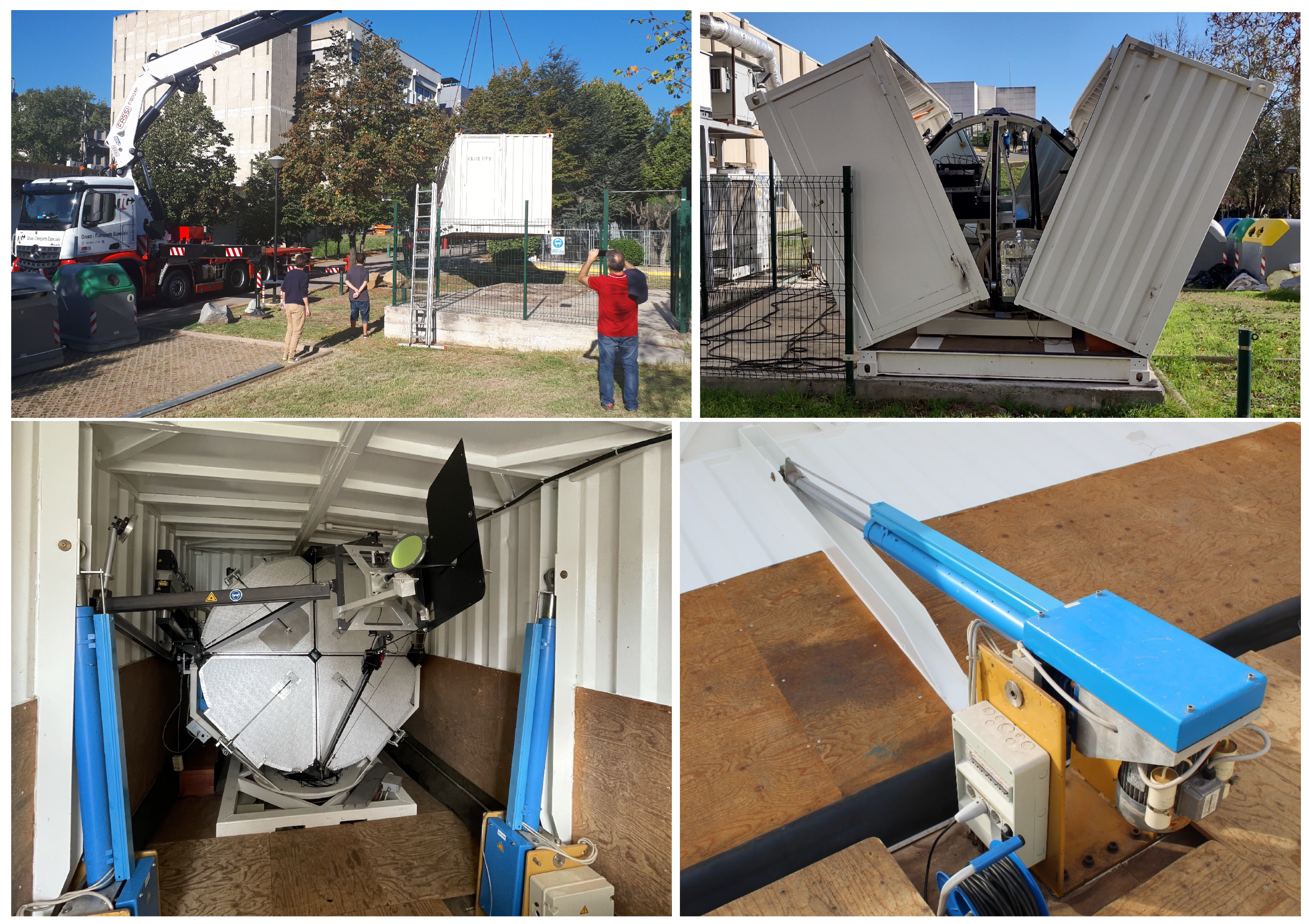


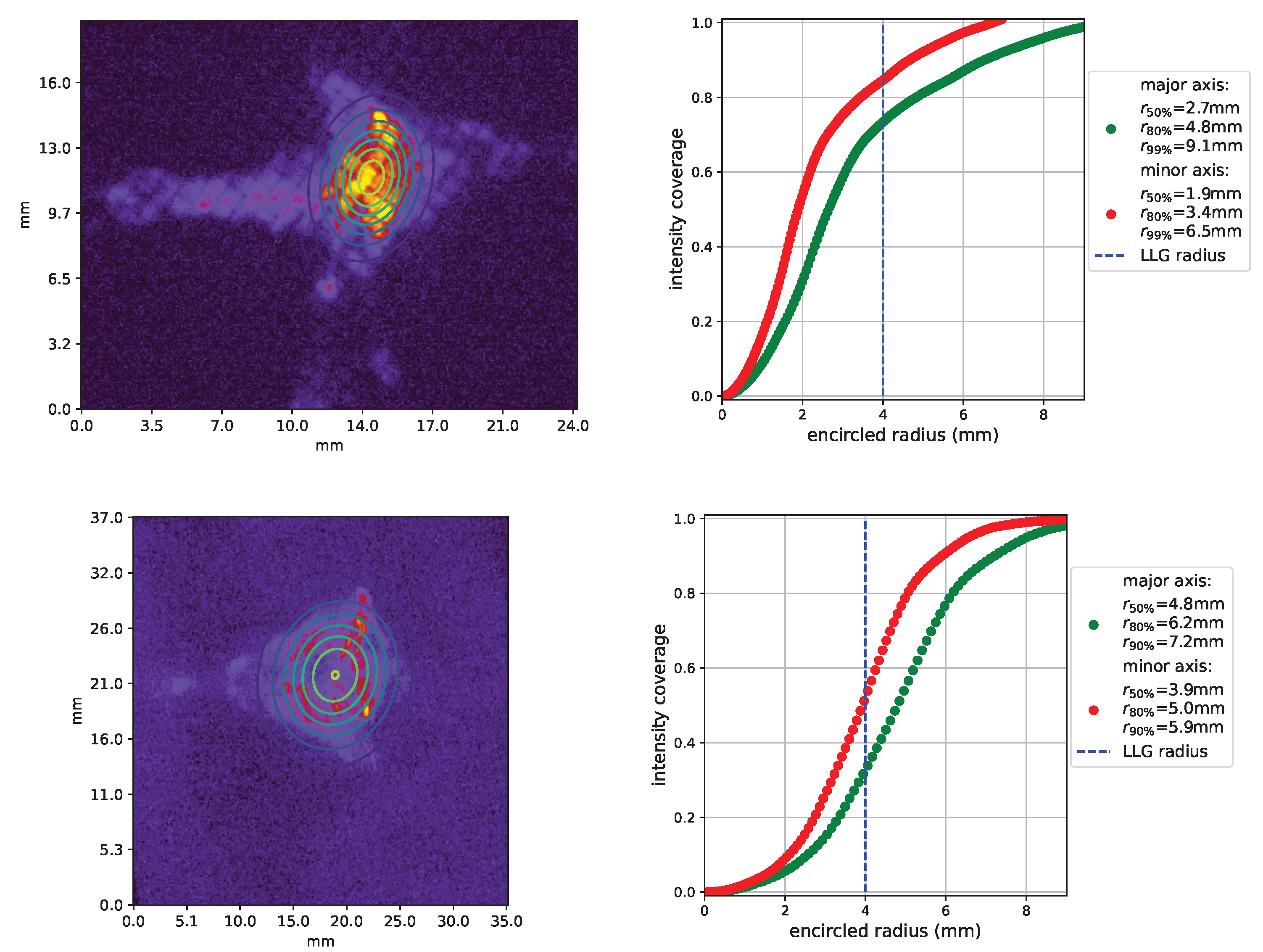

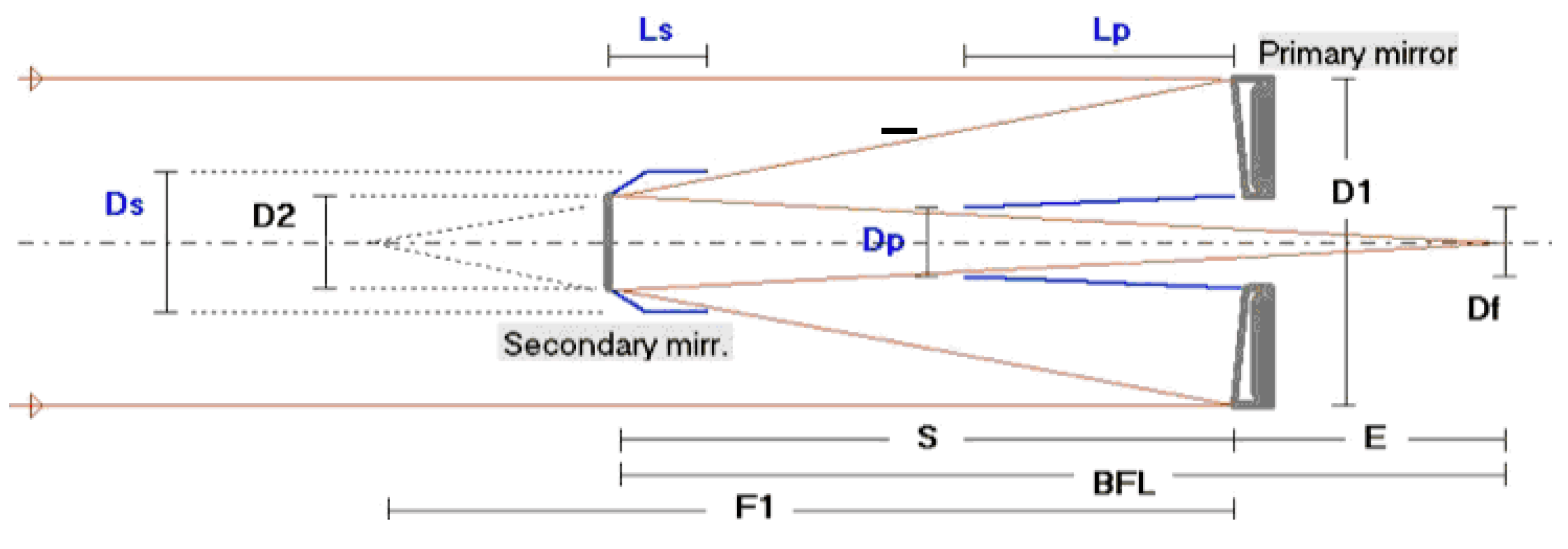

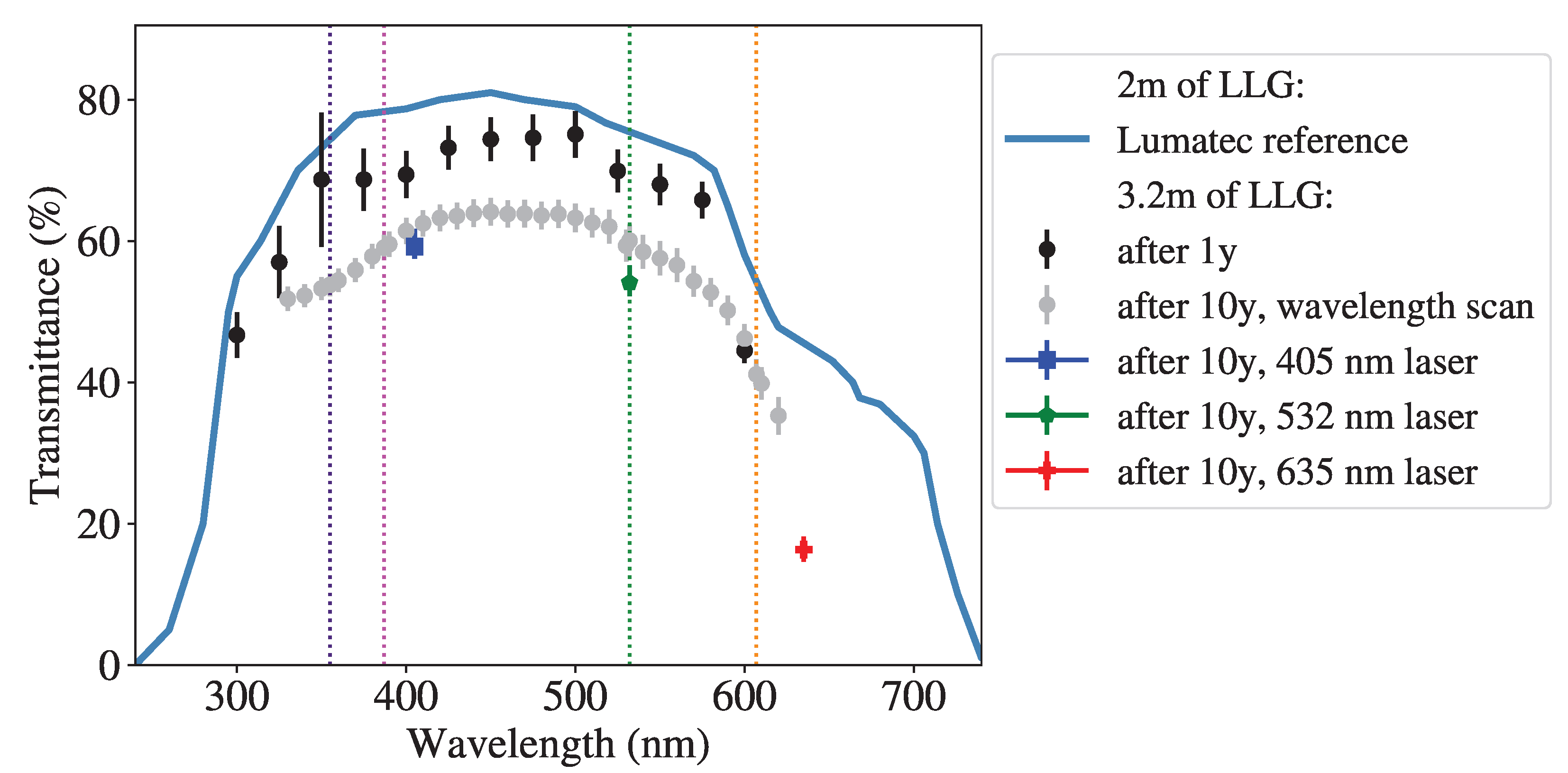
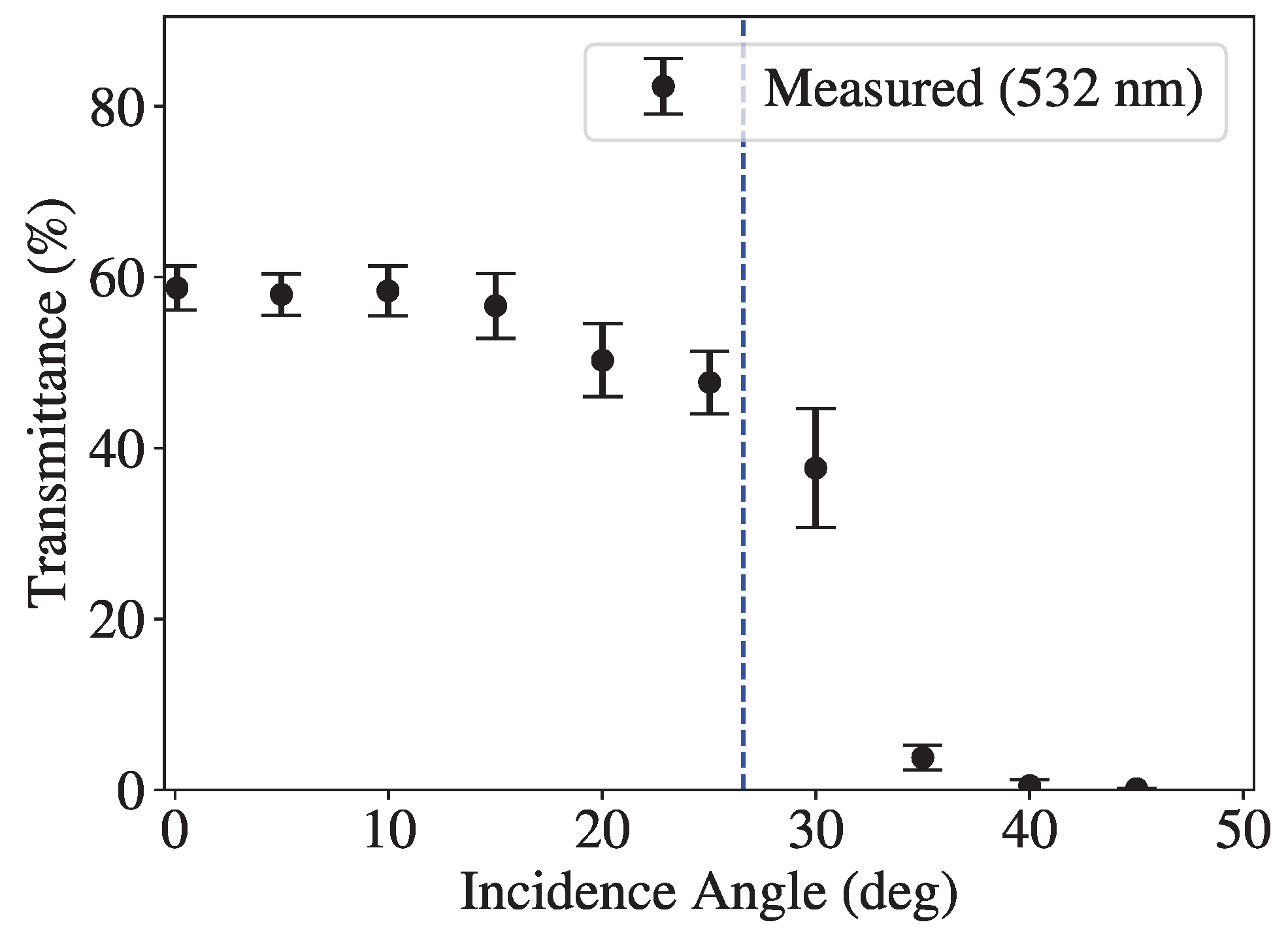
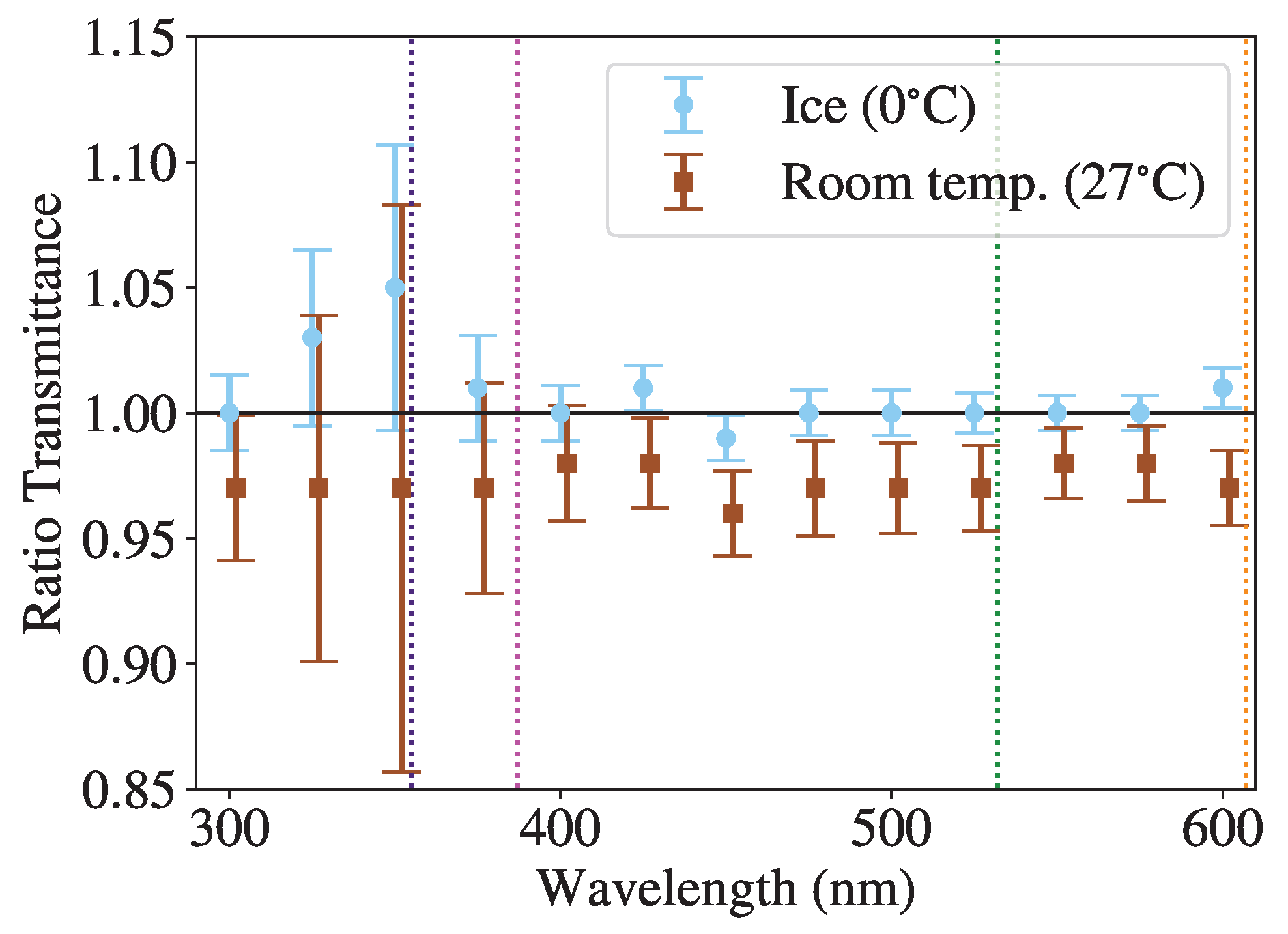
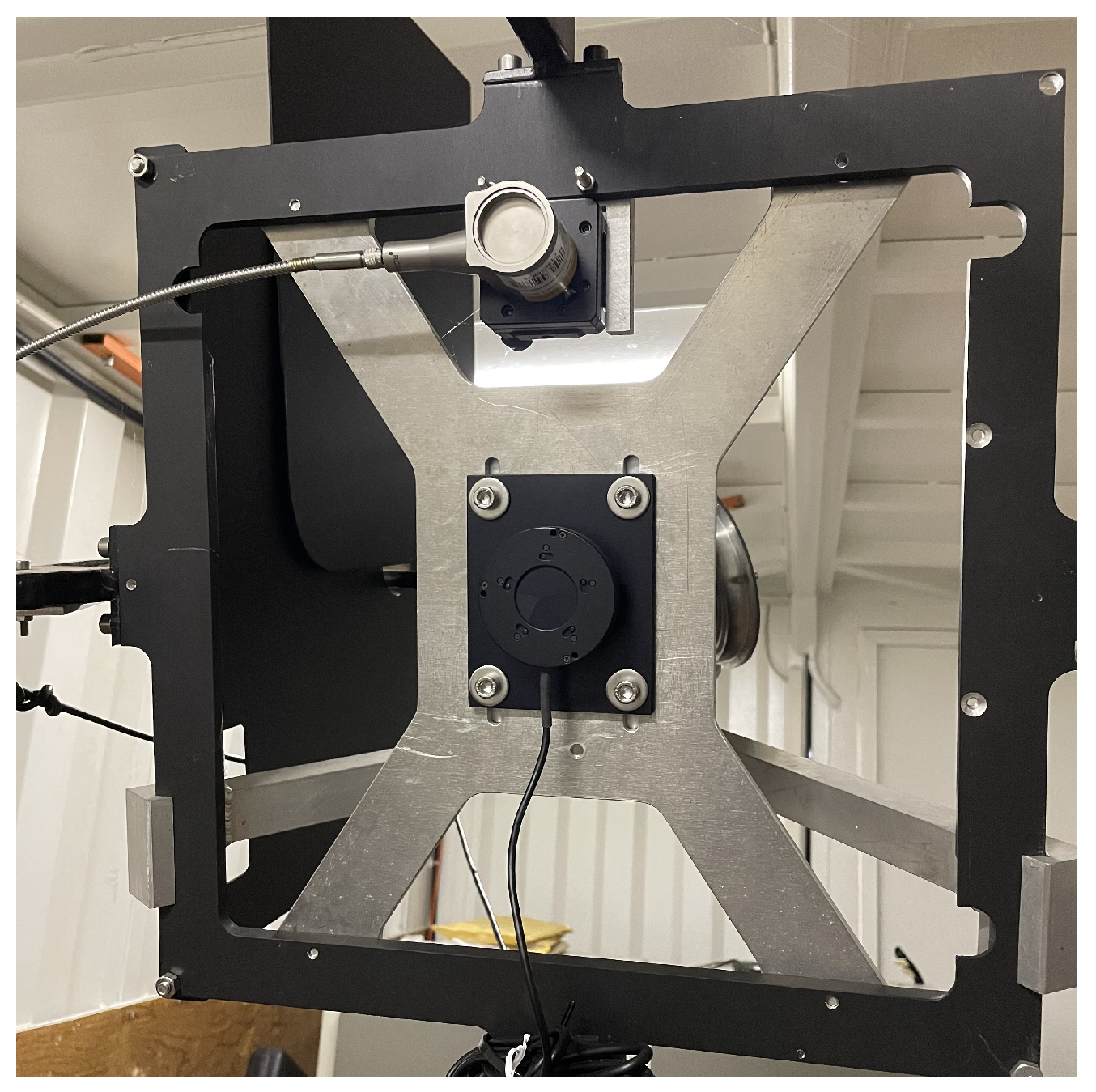






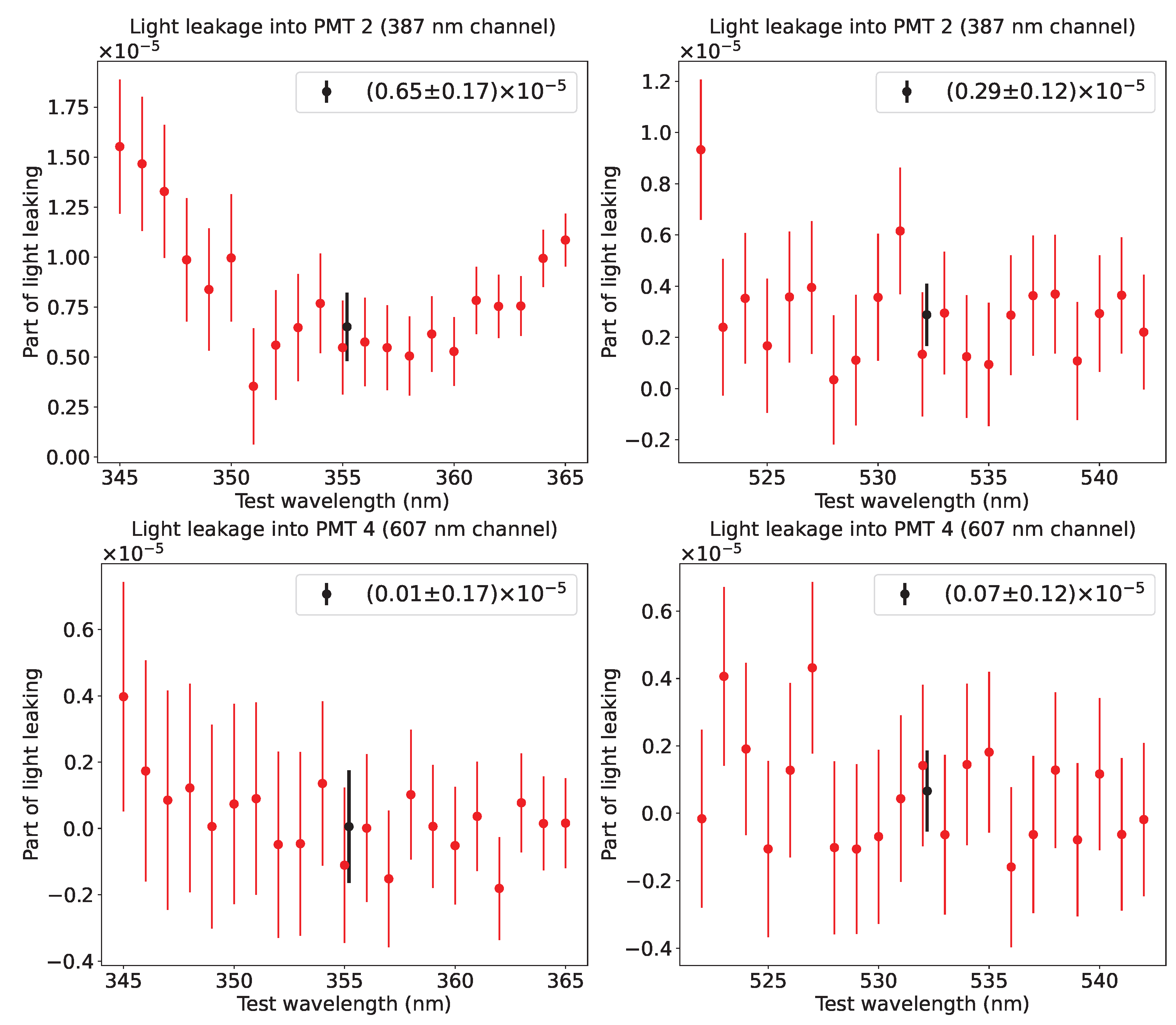
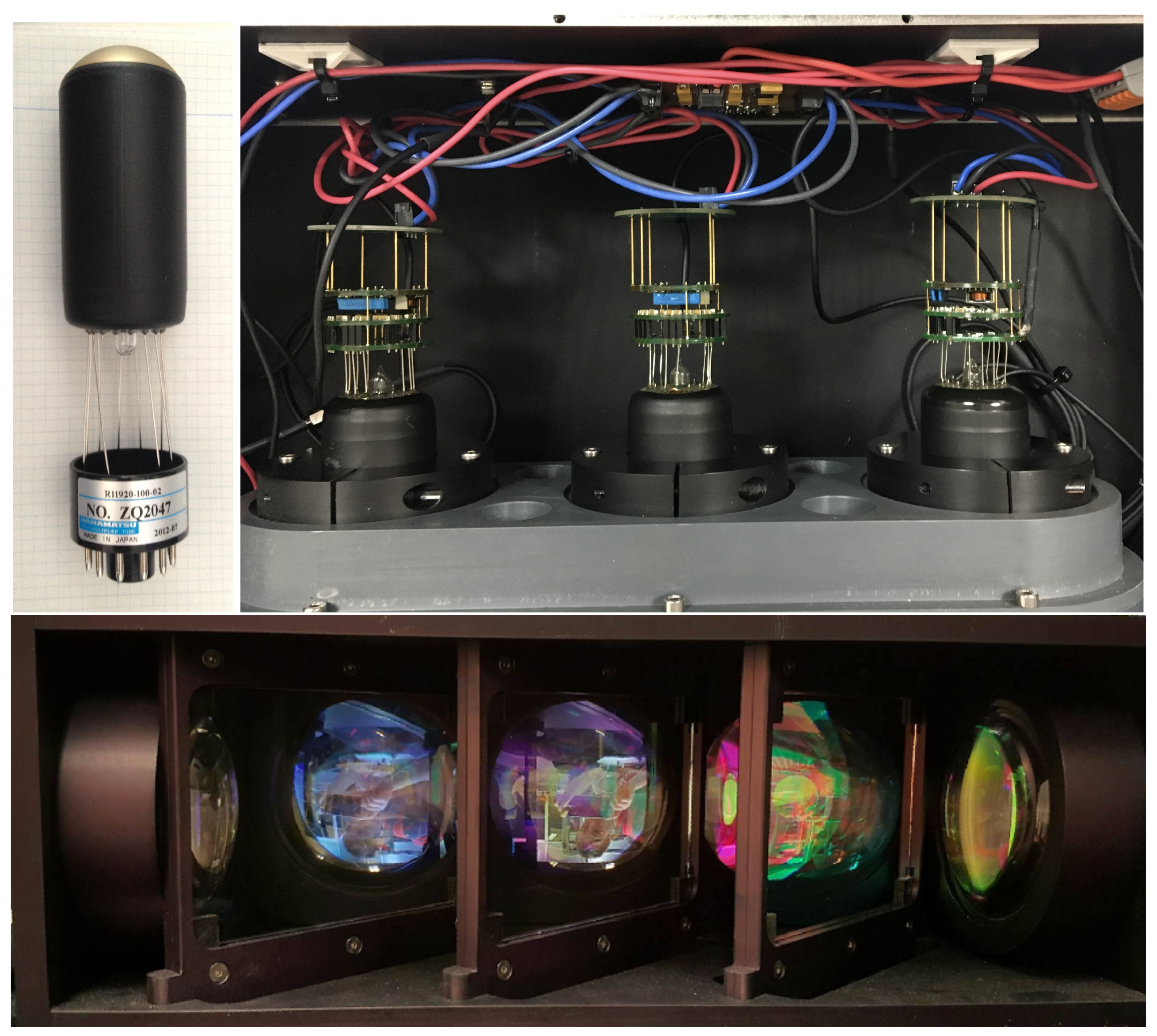

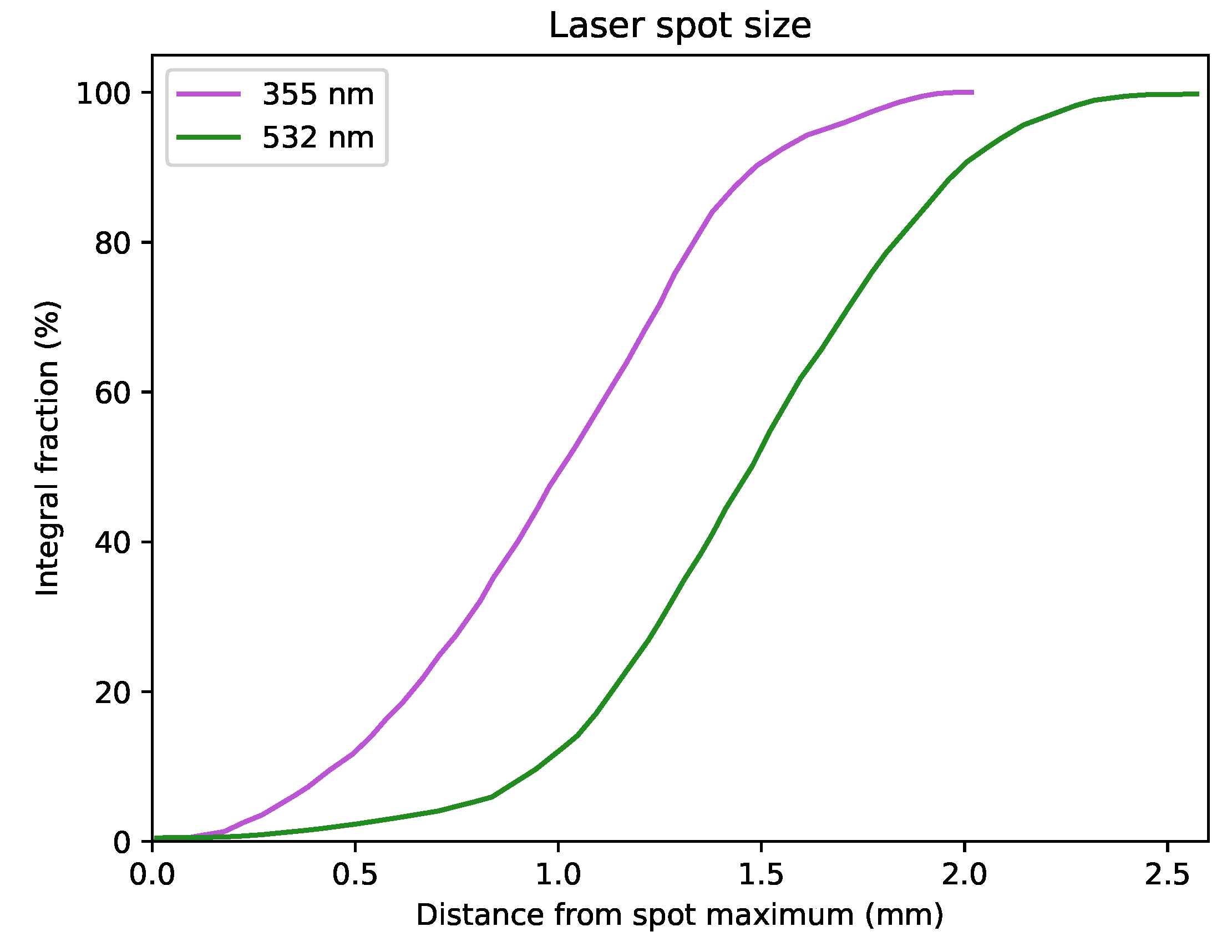

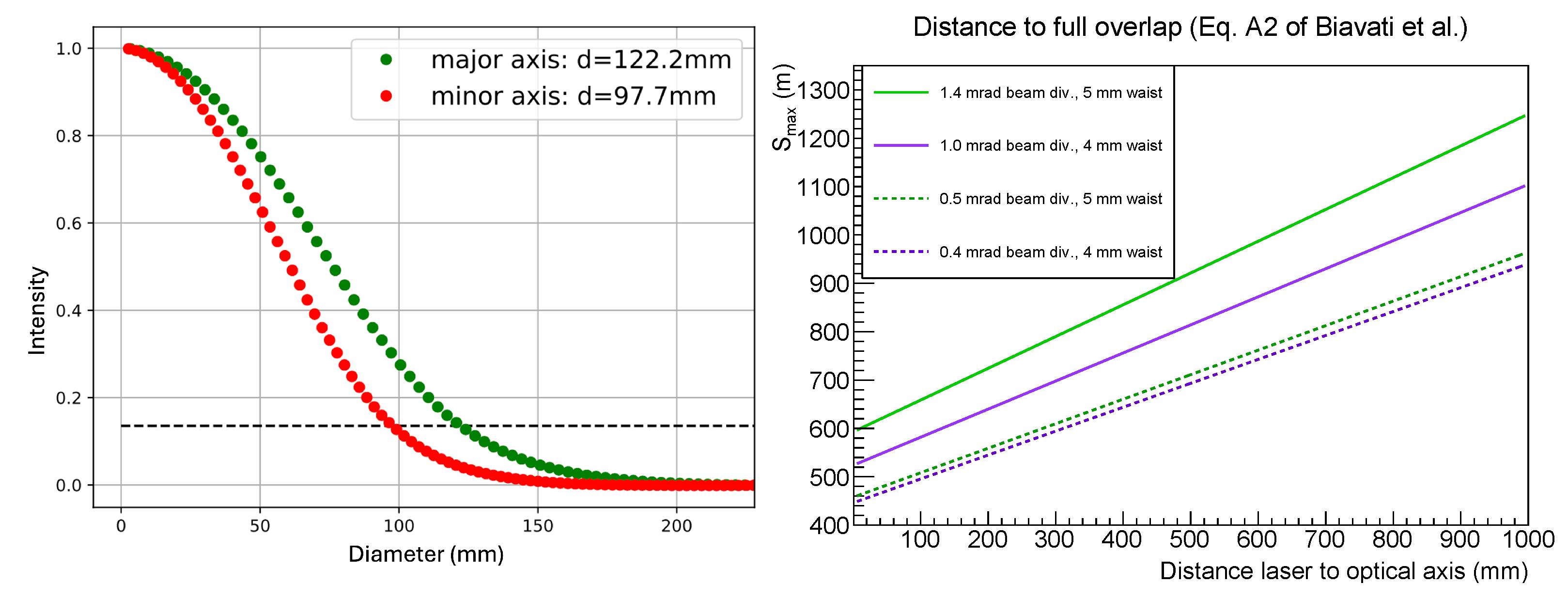
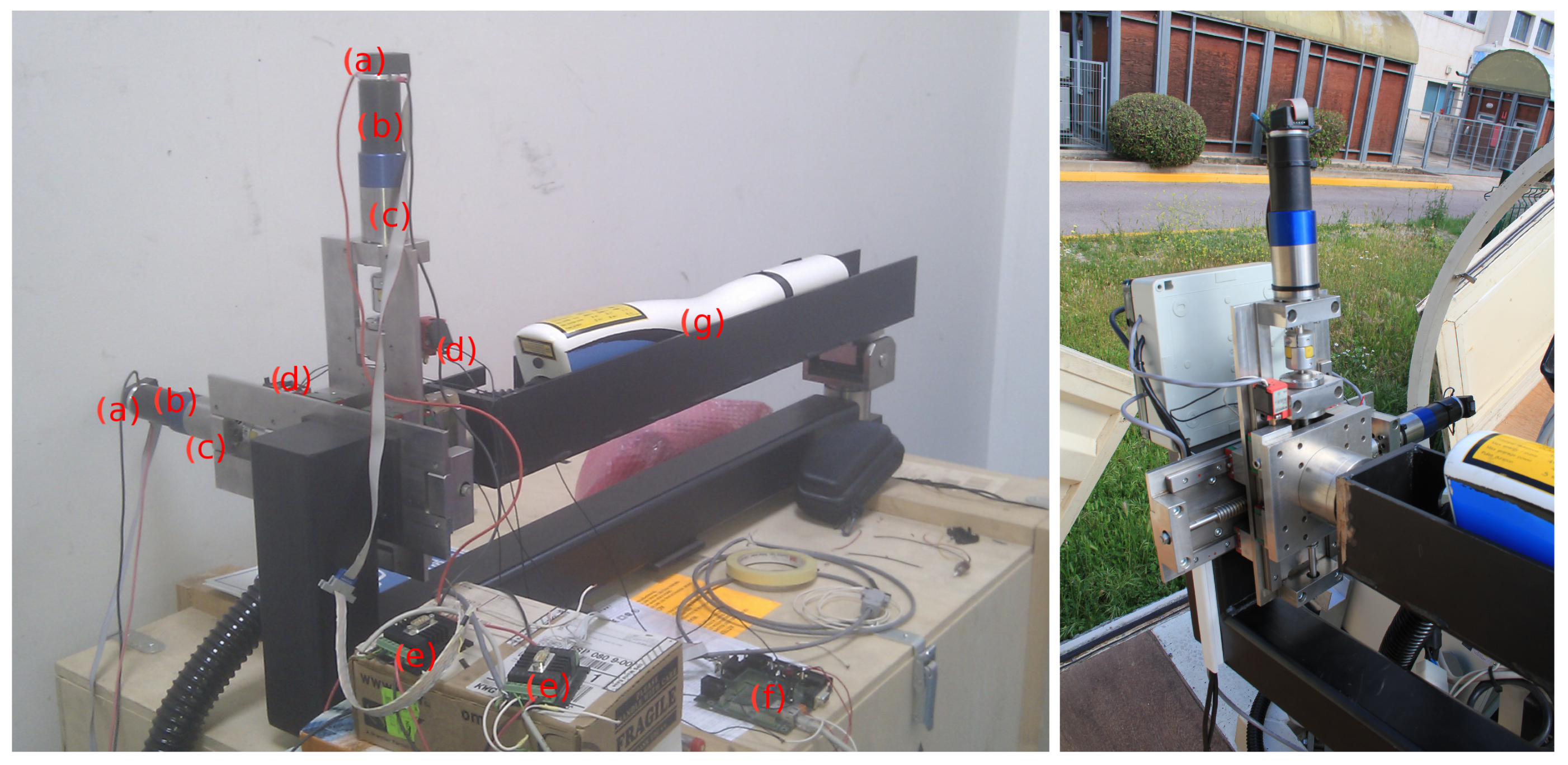
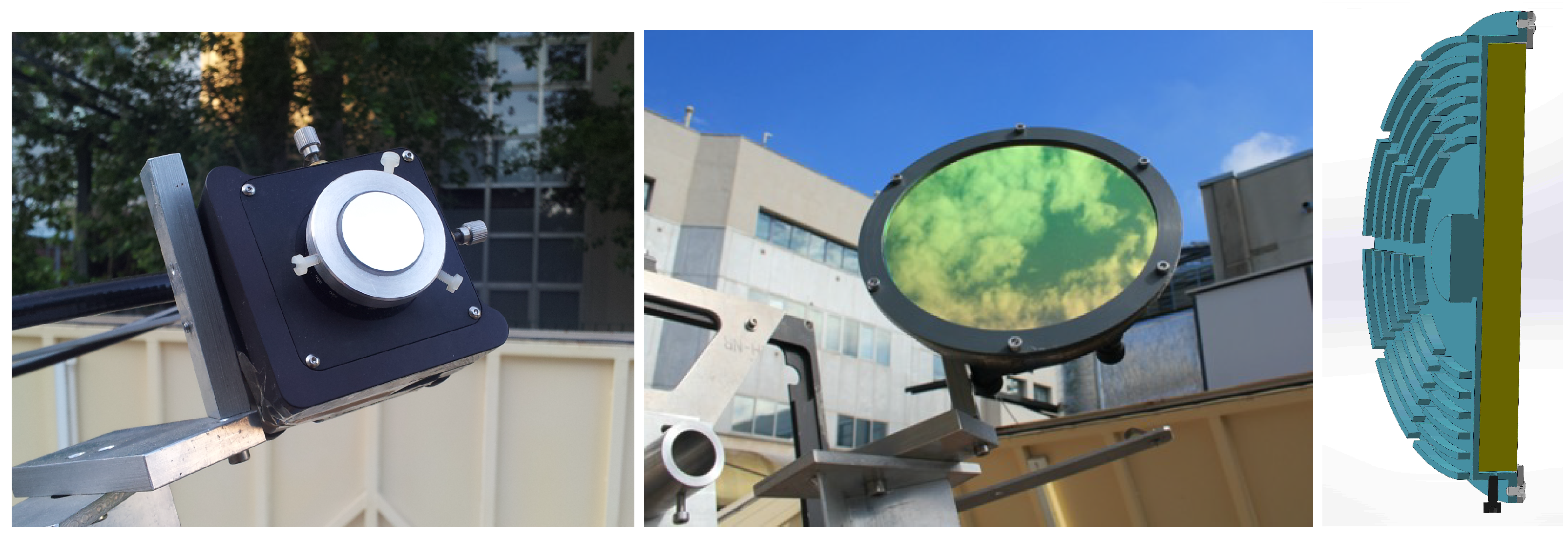
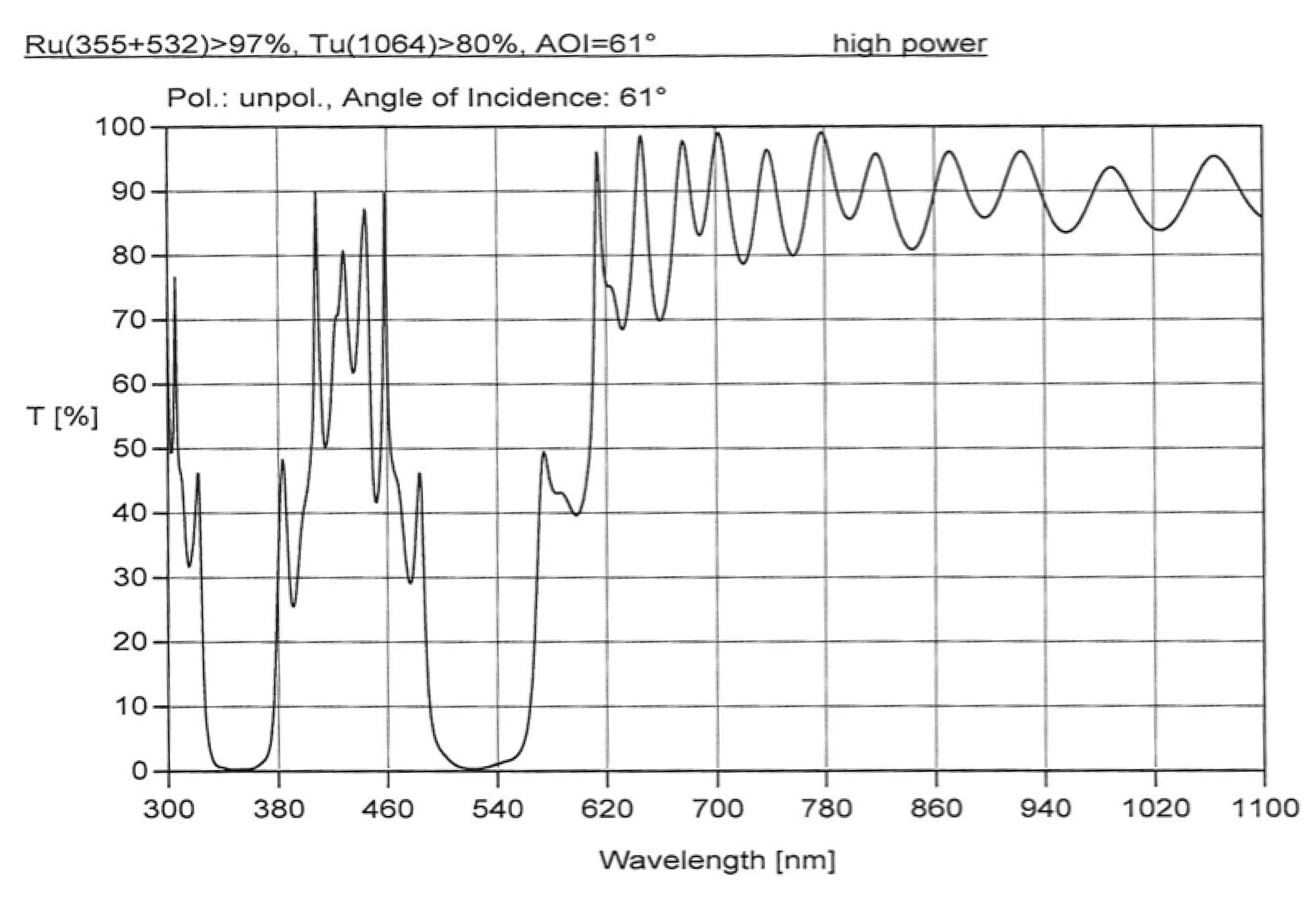
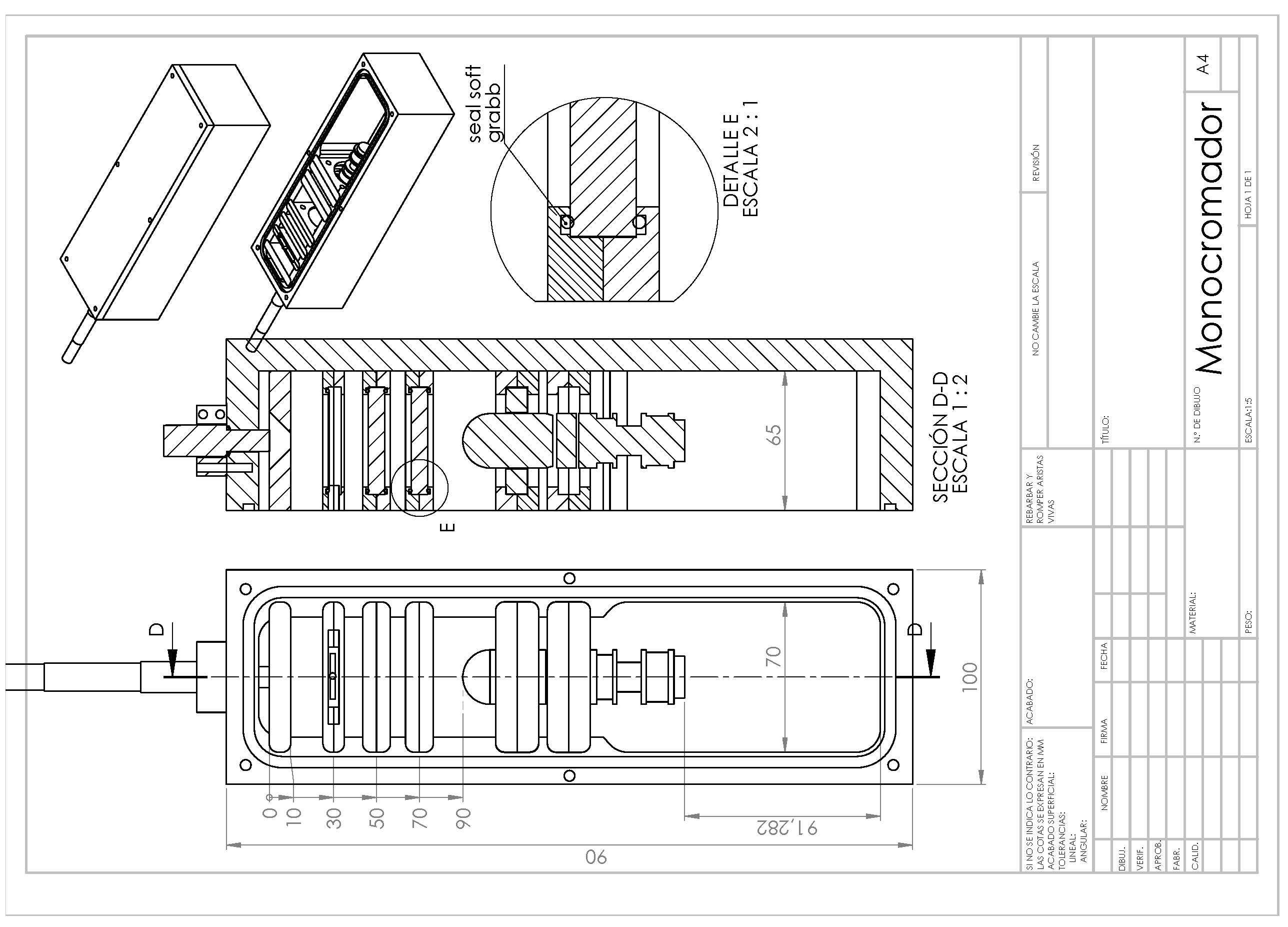

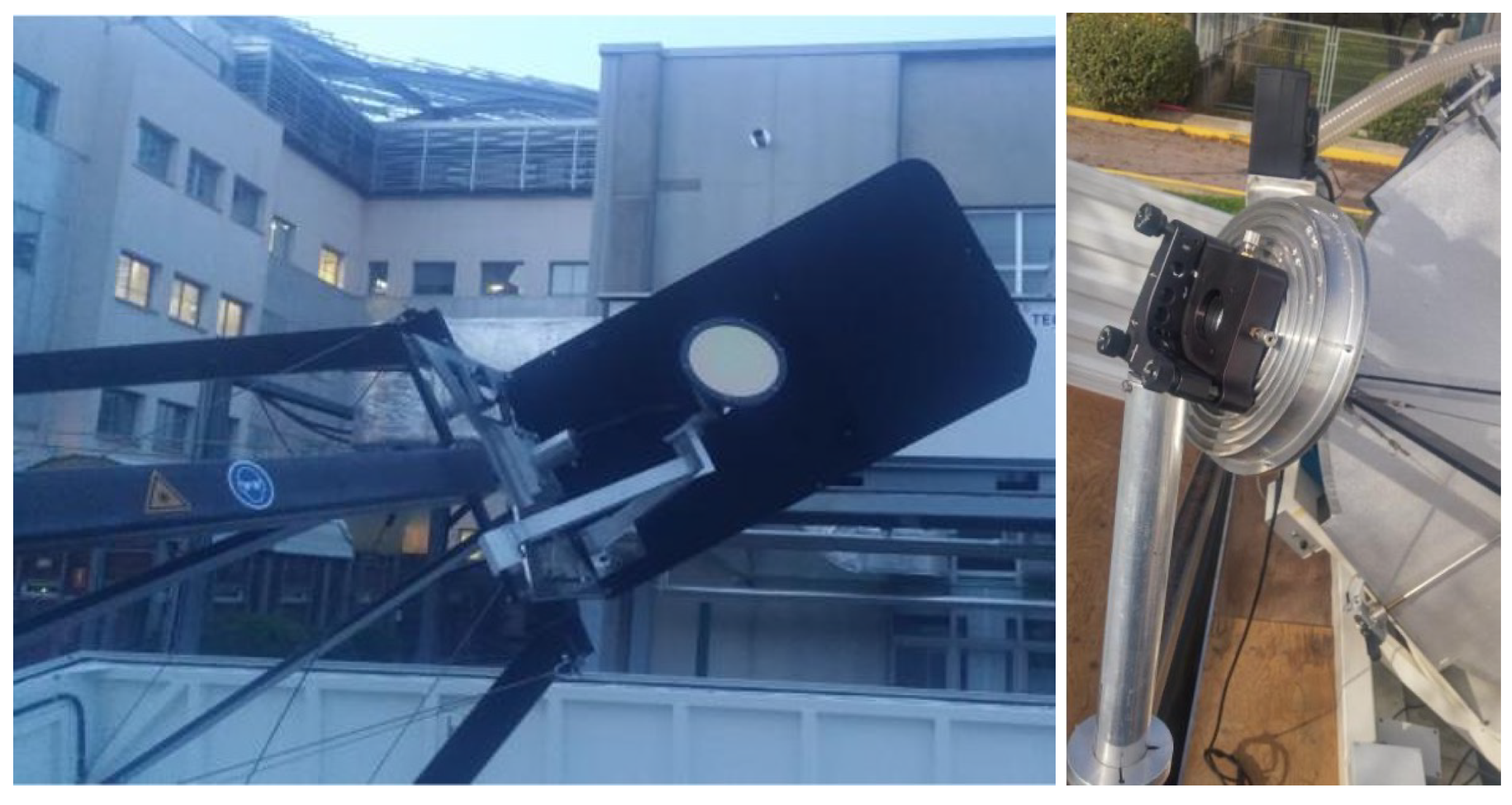
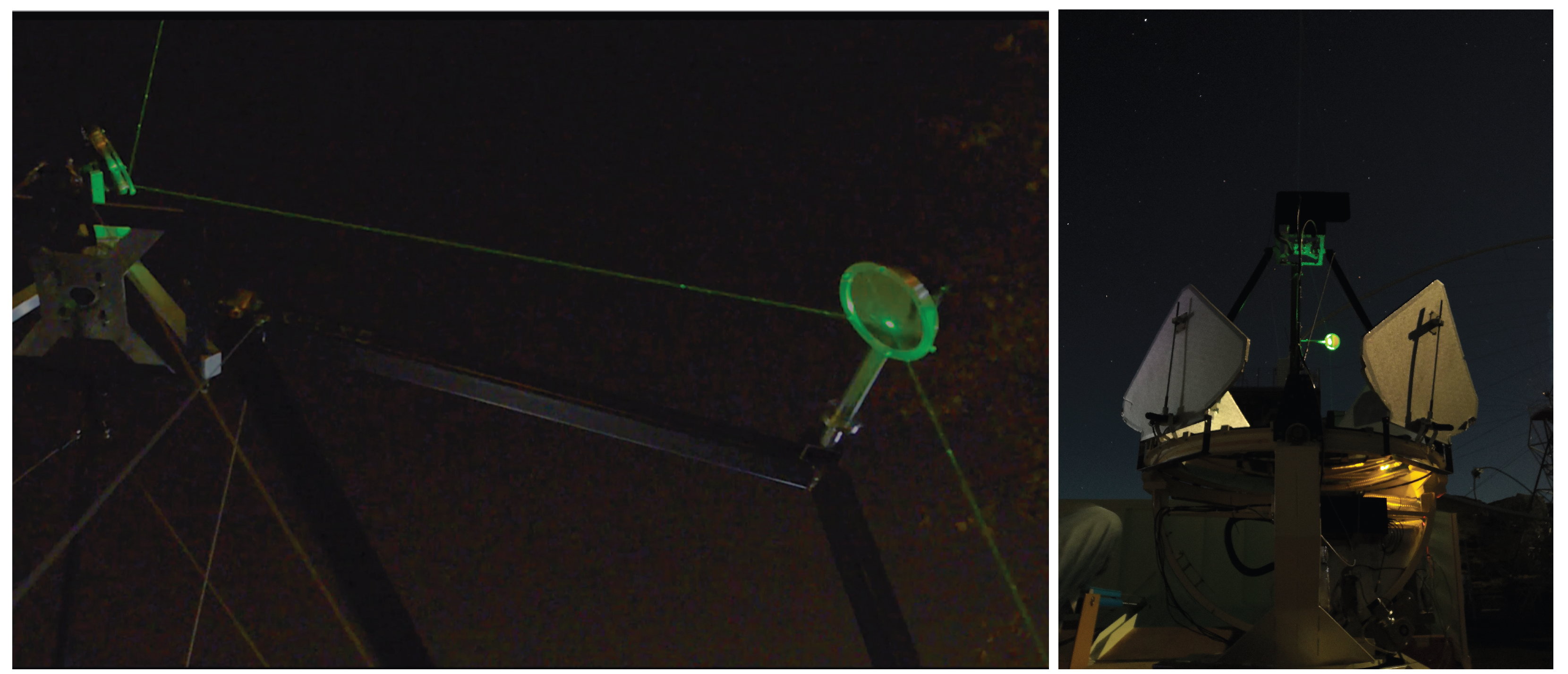


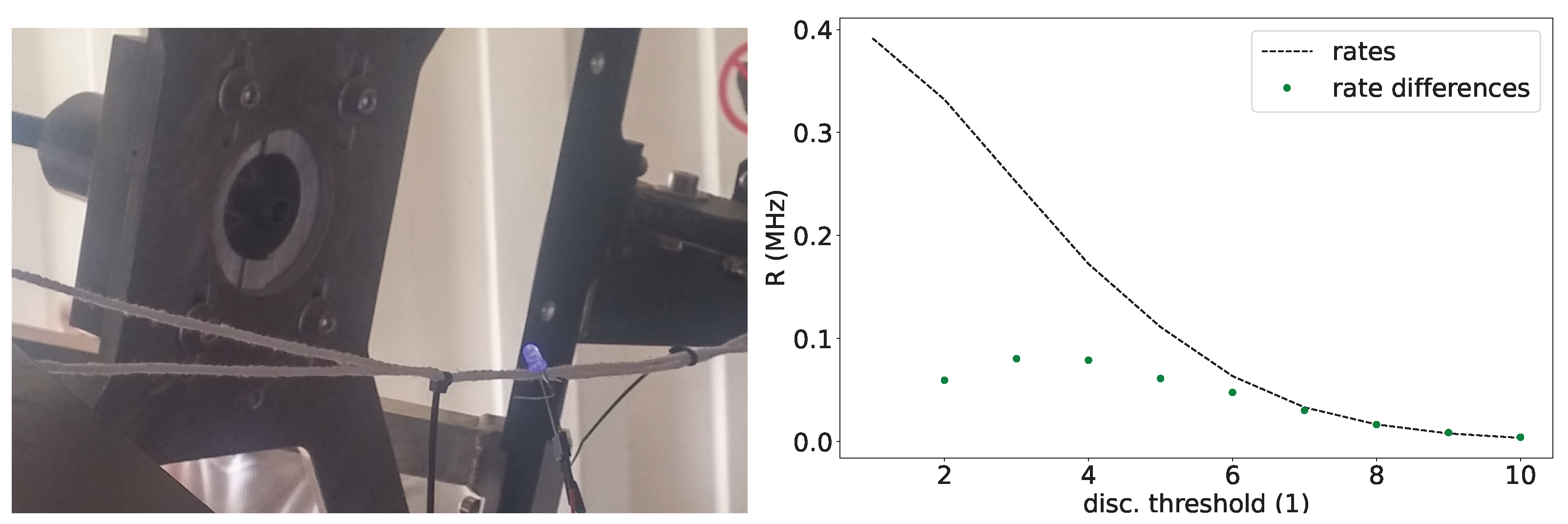


| f/D = 30 | f/D = 8 | ||
|---|---|---|---|
| Effective Focal Length | [m] | 54 | 14.4 |
| Primary Focal Length F1 | [m] | 1.8 | 1.8 |
| Primary Diameter D1 | [m] | 1.8 | 1.8 |
| Primary Focal Plane E | [cm] | 100 | 100 |
| Field Diameter Df | [mm] | 50 | 50 |
| Primary Curvature Radius | [mm] | −3600 | −3600 |
| Secondary Curvature Radius | [mm] | −127 | −483 |
| Primary-Secondary distance | [mm] | −1739 | −1589 |
| Secondary Mirror Diameter | [mm] | 63 | 217 |
| Magnification | 30 | 8 | |
| Back Focal Length | [mm] | 1839 | 1689 |
| Linear Obstruction | % | 3.5 | 12.0 |
| Aperture Ratio | 30 | 8 | |
| Light Shield Length Ls | [mm] | 48.5 | 53.8 |
| Light Shield Length Lp | [mm] | 859 | 824 |
| Light Shield Diameter Ds | [mm] | 112 | 271 |
| Light Shield Diameter Dp | [mm] | 57 | 144 |
| Input Specifications | |
|---|---|
| Input FoV | 70° |
| Input source diameter | 8 mm |
| Wavelength coverage | 355/387/532/607 nm |
| Single photosensor size | 1.5″ hemispherical PMT |
| Design solutions | |
| Optical concept | Sequential beam filtering with dichroic mirrors, plano-convex lens couples and interference filters. |
| Single lens diameter | 100 mm |
| Single lens focal length | 150 mm |
| Single lens curvature radius | 74.5 mm |
| Single lens thickness | 26 mm |
| Material | N-BK7 |
| Single lens transmission at 355 nm | 0.95 |
| Lens couple focal length | 60 mm |
| Distance between two lenses of couple | 2 mm |
| Distance between LLG and first lens couple | 46 mm |
| Filter band pass | 10 nm |
| Parameter | Value | Comments |
|---|---|---|
| 355 nm | ||
| R | 0.95 | after re-aluminization, otherwise <0.3 |
| , , | ||
| PDE | [77] | |
| 0.13 ± 0.02 | ||
| 387 nm | ||
| R | 0.96 | after re-aluminization, otherwise <0.3 |
| , , , | ||
| PDE | [77] | |
| 0.12 ± 0.02 | ||
| 532 nm | ||
| R | 0.97 | after re-aluminization, otherwise <0.3 |
| , , , , | ||
| PDE | [77] | |
| 0.035 ± 0.009 | ||
| 607 nm | ||
| R | 0.97 | after re-aluminization, otherwise <0.3 |
| , , , , | ||
| PDE | [77] | |
| 0.05 ± 0.01 | ||
| Parameter | Value | Notes |
|---|---|---|
| Photocathode diameter | 38.1 mm | 1.5″ |
| Length of PMT | 49.7 mm | PMT only 43 mm, connectors: 6.7 mm |
| Length of HV base | 64.0 mm | |
| Dynodes | 8 | |
| Power | +5 V/GND | HV produced internally in PMT base by a Cockcroft–Walton circuit |
| Control voltage | +0.9–+1.5 V | Correspondance of 1/1000 |
| QE@355 nm | 41% | [77,78] |
| QE@387 nm | 42% | |
| QE@532 nm | 13% | |
| QE@607 nm | 4% | |
| Gain | (2–3) × 105 | at HV ≈ 1200 V [77] |
| Pulse width | 2.0 ns | at HV ≈ 1500 V [69,77] |
| Afterpulse rate | <10−3 | for ≥1 p.e. [77] |
| <2 × 10−4 | for ≥2 p.e. [77] |
| Environmental: | |
|---|---|
| Operating temperature: | +10 °C to +40 °C |
| Storage temperature: | −30 °C to +70 °C |
| Humidity: | 0 to 95%, non-condensing. |
| Dimensions: | |
| Rack: | 448.6 × 311.5 × 361 mm housing |
| for 19” rack mounting | |
| LOTR Modules | RF-shielded cassette 6U (3U mounted in 6U) |
| Acquisition: | |
| Signal input range: | 0...−500 mV |
| A/D Resolution: | 12 Bit/16 Bit |
| Sampling rate: | 20 MSamples/s (40 MSamples/s) |
| Spatial resolution: | 7.5 m (3.75) m |
| Bandwidth: | DC-10 (20) MHz |
| A/D differential nonlinearity: | typ. 0.65 (0.5) LSB max. 1.25 (3) LSB at 25 °C |
| A/D integral nonlinearity: | typ. 1 (3) LSB at 25 °C |
| Spurious free dynamic range: | 74 (88) dB |
| S/N single shot: | 66 (74) dB at 100 mV input range |
| Memory depth: | 16,384 (32,768) bins |
| Summation memory: | 2 channels, up to 4094 acquisitions |
| Max. photon counting rate | 250 (800) MHz |
| General Characteristics | |
|---|---|
| Pulse repetition rate | 10 Hz |
| Power drift | 3% |
| Pointing Stability | <75 µrad |
| Pulse jitter (1064 nm) | ±0.5 ns |
| Beam divergence full-angle (1064 nm) | 0.5 mrad |
| Beam waist diameter (1064 nm) | 6 mm |
| Wavelength-Dependent Parameters | ||||
|---|---|---|---|---|
|
Wavelength (nm) |
Nominal Energy per Pulse (mJ) | Maximum Average Power (W) |
Pulse Duration (ns) |
Energy Stability Shot-to-Shot (%) |
| 1064 | 360 | 3.6 | ∼ 5 | ±2 (0.6) |
| (after repair) | 250 | 2.5 | ||
| 532 | 180 | 1.8 | ∼ 4 | ±4 (1.3) |
| (after repair) | 128 | 1.3 | ||
| 355 | 100 | 1 | ∼ 4 | ±6 (2) |
| (after repair) | 80 | 0.8 | ||
| (mm) | (mrad) | (mm) | (mrad) | (°) |
|---|---|---|---|---|
Disclaimer/Publisher’s Note: The statements, opinions and data contained in all publications are solely those of the individual author(s) and contributor(s) and not of MDPI and/or the editor(s). MDPI and/or the editor(s) disclaim responsibility for any injury to people or property resulting from any ideas, methods, instructions or products referred to in the content. |
© 2025 by the authors. Licensee MDPI, Basel, Switzerland. This article is an open access article distributed under the terms and conditions of the Creative Commons Attribution (CC BY) license (https://creativecommons.org/licenses/by/4.0/).
Share and Cite
Ballester, O.; Blanch, O.; Boix, J.; Calisse, P.G.; Campoy-Ordaz, A.; Çolak, S.M.; Da Deppo, V.; Doro, M.; Font, L.; Font-Pladevall, E.; et al. A 1.8 m Class Pathfinder Raman LIDAR for the Northern Site of the Cherenkov Telescope Array Observatory—Technical Design. Remote Sens. 2025, 17, 1074. https://doi.org/10.3390/rs17061074
Ballester O, Blanch O, Boix J, Calisse PG, Campoy-Ordaz A, Çolak SM, Da Deppo V, Doro M, Font L, Font-Pladevall E, et al. A 1.8 m Class Pathfinder Raman LIDAR for the Northern Site of the Cherenkov Telescope Array Observatory—Technical Design. Remote Sensing. 2025; 17(6):1074. https://doi.org/10.3390/rs17061074
Chicago/Turabian StyleBallester, Otger, Oscar Blanch, Joan Boix, Paolo G. Calisse, Anna Campoy-Ordaz, Sidika Merve Çolak, Vania Da Deppo, Michele Doro, Lluís Font, Eudald Font-Pladevall, and et al. 2025. "A 1.8 m Class Pathfinder Raman LIDAR for the Northern Site of the Cherenkov Telescope Array Observatory—Technical Design" Remote Sensing 17, no. 6: 1074. https://doi.org/10.3390/rs17061074
APA StyleBallester, O., Blanch, O., Boix, J., Calisse, P. G., Campoy-Ordaz, A., Çolak, S. M., Da Deppo, V., Doro, M., Font, L., Font-Pladevall, E., Garcia, R., Gaug, M., Grau, R., Kolar, D., López-Oramas, A., Maggio, C., Martinez, M., Martínez, Ò., Riu-Molinero, V., ... Živec, M. (2025). A 1.8 m Class Pathfinder Raman LIDAR for the Northern Site of the Cherenkov Telescope Array Observatory—Technical Design. Remote Sensing, 17(6), 1074. https://doi.org/10.3390/rs17061074







